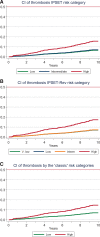Application of IPSET-thrombosis in 1366 Patients Prospectively Followed From the Spanish Registry of Essential Thrombocythemia
- PMID: 37476303
- PMCID: PMC10356121
- DOI: 10.1097/HS9.0000000000000936
Application of IPSET-thrombosis in 1366 Patients Prospectively Followed From the Spanish Registry of Essential Thrombocythemia
Abstract
The International Prognostic Score of thrombosis in Essential Thrombocythemia (IPSET-thrombosis) and its revised version have been proposed to guide thrombosis prevention strategies. We evaluated both classifications to prognosticate thrombosis in 1366 contemporary essential thrombocythemia (ET) patients prospectively followed from the Spanish Registry of ET. The cumulative incidence of thrombosis at 10 years, taking death as a competing risk, was 11.4%. The risk of thrombosis was significantly higher in the high-risk IPSET-thrombosis and high-risk revised IPSET-thrombosis, but no differences were observed among the lower risk categories. Patients allocated in high-risk IPSET-thrombosis (subdistribution hazard ratios [SHR], 3.7 [95% confidence interval, CI, 1.6-8.7]) and high-risk revised IPSET-thrombosis (SHR, 3.2 [95% CI, 1.4-7.45]) showed an increased risk of arterial thrombosis, whereas both scoring systems failed to predict venous thrombosis. The incidence rate of thrombosis in intermediate risk revised IPSET-thrombosis (aged >60 years, JAK2-negative, and no history of thrombosis) was very low regardless of the treatment administered (0.9% and 0% per year with and without cytoreduction, respectively). Dynamic application of the revised IPSET-thrombosis showed a low rate of thrombosis when patients without history of prior thrombosis switched to a higher risk category after reaching 60 years of age. In conclusion, IPSET-thrombosis scores are useful for identifying patients at high risk of arterial thrombosis, whereas they fail to predict venous thrombosis. Controlled studies are needed to determine the appropriate treatment of ET patients assigned to the non-high-risk categories.
Copyright © 2023 the Author(s). Published by Wolters Kluwer Health, Inc. on behalf of the European Hematology Association.
Conflict of interest statement
The authors have no conflicts of interest to disclose.
Figures



References
-
- Besses C, Cervantes F, Pereira A, et al. . Major vascular complications in essential thrombocythemia: a study of the predictive factors in a series of 148 patients. Leukemia. 1999;13:150–154. - PubMed
-
- Cortelazzo S, Viero P, Finazzi G, et al. . Incidence and risk factors for thrombotic complications in a historical cohort of 100 patients with essential thrombocythemia. J Clin Oncol. 1990;8:556–562. - PubMed
-
- Barbui T, Finazzi G, Carobbio A, et al. . Development and validation of an International Prognostic Score of thrombosis in World Health Organization-essential thrombocythemia (IPSET-thrombosis). Blood. 2012;120:5128–33; quiz 5252. - PubMed
LinkOut - more resources
Full Text Sources
Miscellaneous
